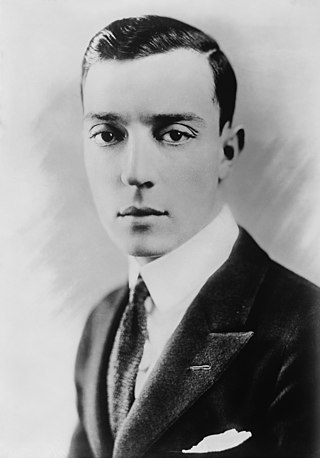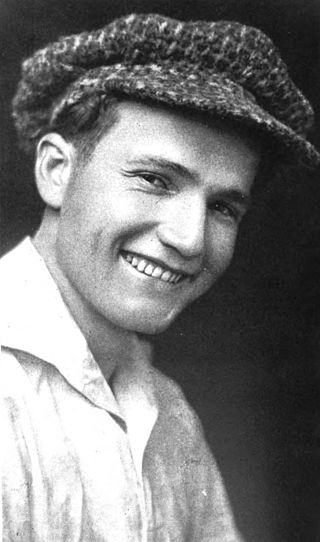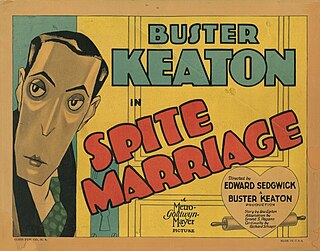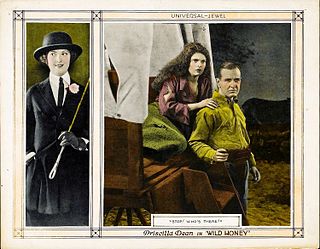
Joseph Frank "Buster" Keaton was an American actor, comedian and film director. He is best known for his silent films during the 1920s, in which he performed physical comedy and inventive stunts. He frequently maintained a stoic, deadpan facial expression that became his trademark and earned him the nickname "The Great Stone Face".

The General is a 1926 American silent slapstick Western action comedy film released by United Artists. It was inspired by the Great Locomotive Chase, a true story of an event that occurred during the American Civil War. The story was adapted from the 1889 memoir The Great Locomotive Chase by William Pittenger. The film stars Buster Keaton, who also co-directed it along with Clyde Bruckman.

Sherlock Jr. is a 1924 American silent comedy film starring and directed by Buster Keaton and written by Clyde Bruckman, Jean Havez, and Joseph A. Mitchell. It features Kathryn McGuire, Joe Keaton, and Ward Crane.

Roscoe Conkling "Fatty" Arbuckle was an American silent film actor, director, and screenwriter. He started at the Selig Polyscope Company and eventually moved to Keystone Studios, where he worked with Mabel Normand and Harold Lloyd as well as with his nephew, Al St. John. He also mentored Charlie Chaplin, Monty Banks and Bob Hope, and brought vaudeville star Buster Keaton into the movie business. Arbuckle was one of the most popular silent stars of the 1910s and one of the highest-paid actors in Hollywood, signing a contract in 1920 with Paramount Pictures for $1,000,000 a year.

Wallace Fitzgerald Beery was an American film and stage actor. He is best known for his portrayal of Bill in Min and Bill (1930) opposite Marie Dressler, as General Director Preysing in Grand Hotel (1932), as Long John Silver in Treasure Island (1934), as Pancho Villa in Viva Villa! (1934), and his title role in The Champ (1931), for which he won the Academy Award for Best Actor. Beery appeared in some 250 films during a 36-year career. His contract with Metro-Goldwyn-Mayer stipulated in 1932 that he would be paid $1 more than any other contract player at the studio. This made Beery the highest-paid film actor in the world during the early 1930s. He was the brother of actor Noah Beery and uncle of actor Noah Beery Jr.
This is an overview of 1923 in film, including significant events, a list of films released and notable births and deaths.
This is an overview of 1922 in film, including significant events, a list of films released and notable births and deaths.

Noah Nicholas Beery was an American actor who appeared in films from 1913 until his death in 1946. He was the older brother of Academy Award-winning actor Wallace Beery as well as the father of prominent character actor Noah Beery Jr. He was billed as either Noah Beery or Noah Beery Sr. depending upon the film.

One Week is a 1920 American two-reel silent comedy film starring Buster Keaton, the first independent film production he released on his own. The film was written and directed by Keaton and Edward F. Cline, and runs for 19 minutes. Sybil Seely co-stars. The film contains a large number of innovative visual gags largely pertaining to either the house or to ladders.

Our Hospitality is a 1923 American silent comedy film directed by Buster Keaton and John G. Blystone. Starring Keaton, Joe Roberts, and Natalie Talmadge and distributed by Metro Pictures Corporation, it uses slapstick and situational comedy to tell the story of Willie McKay, caught in the middle of the infamous "Canfield–McKay" feud, an obvious satire of the real-life Hatfield–McCoy feud.

Tom Forman was an American motion picture actor, director, writer, and producer of the early 1920s.

Margaret Leahy was a British actress. After winning a beauty contest, Leahy made only one film.

The Round-Up is a 1920 American silent Western film starring Roscoe "Fatty" Arbuckle and featuring Wallace Beery. The movie was written by Edmund Day and Tom Forman, directed by George Melford, and based on Day's play that was a huge hit for Roscoe Arbuckle's older cousin Macklyn Arbuckle and Julia Dean on the Broadway stage in 1907. It was Macklyn in the play who created the famous phrase used in advertisements of the film, nobody loves a fat man.

The Flame of Life is a 1923 American silent drama film starring Priscilla Dean, Robert Ellis, Kathryn McGuire, and Wallace Beery. The film was written by Elliott J. Clawson from the Frances Hodgson Burnett novel That Lass o' Lowrie's and directed by Hobart Henley.

Spite Marriage is a 1929 American silent comedy film co-directed by Buster Keaton and Edward Sedgwick and starring Keaton and Dorothy Sebastian. It is the second film Keaton made for MGM and his last silent film, although he had wanted it to be a "talkie" or full sound film. While the production has no recorded dialogue, it does feature an accompanying synchronized score and recorded laughter, applause and other sound effects in some scenes. Keaton later wrote gags for some up-and-coming MGM stars like Red Skelton, and from this film recycled many gags, some shot-for-shot, for Skelton's 1943 film I Dood It.

Coney Island is a 1917 American two-reel silent comedy film starring, written and directed by Roscoe "Fatty" Arbuckle and featuring Buster Keaton.

The Frozen North is a 1922 American short comedy film directed by and starring Buster Keaton. The film is a parody of early western films, especially those of William S. Hart. The film was written by Keaton and Edward F. Cline. The film runs for around 17 minutes. Sybil Seely and Bonnie Hill co-star in the film.

Adam's Rib is a 1923 American silent drama film directed by Cecil B. DeMille. It was written by Jeanie MacPherson. For the dinosaurs represented in the film, Ray S. Bassler acted as technical advisor. The filmed premiered at New York's Rivoli Theatre on February 25, 1923.
Photoplay Productions is an independent film company, based in the UK, under the direction of Kevin Brownlow and Patrick Stanbury. Is one of the few independent companies to operate in the revival of interest in the lost world of silent cinema and has been recognised as a driving force in the subject.

Wild Honey is a 1922 American silent romantic adventure film directed by Wesley Ruggles. Produced and distributed by the Universal Film Manufacturing Company, the film is based on a book of the same title by Cynthia Stockley and stars Priscilla Dean, and features Noah Beery, Sr. and Wallace Beery in supporting roles. It is notable for the first use of a traveling matte special effect.

















